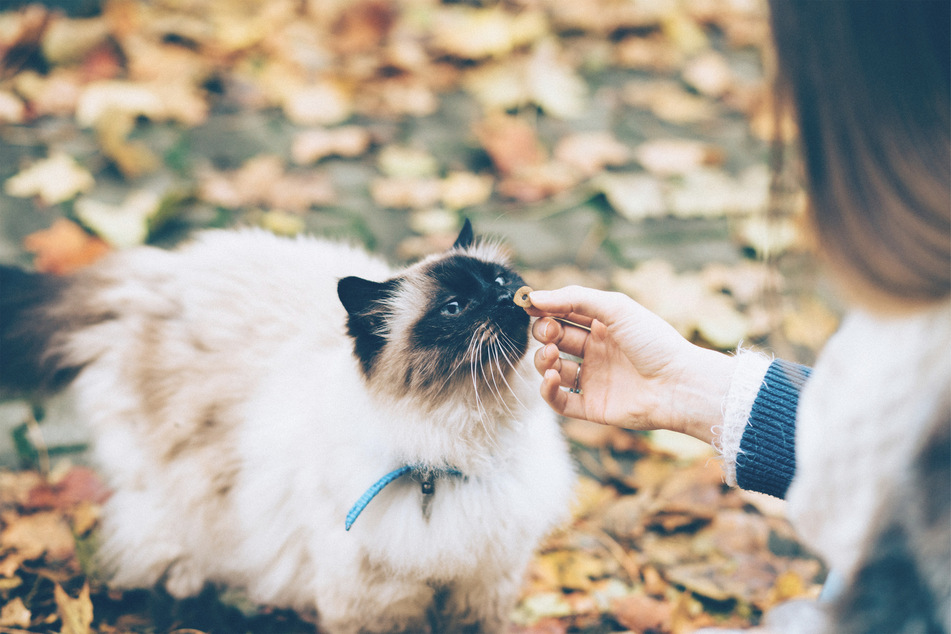How to train a cat: What can you train a cat to do?
You might've assumed that there's no way to train your cat, that there's no way to fix its behavior. Luckily, there are some tips and tricks to help you out. Here's how to train your cat, what you can train your cat to do, and how to improve that kitty behavior.

Cats can get naughty sometimes, shredding curtains and spreading their fur around the house, leaving rolling puffs of cat-produced tumbleweed crawling across the floor.
When it gets especially bad, scratches will become more common and the cat-human relationship will suffer severely.
But is there anything you can do about it? Can you actually train a cat?
In this cat guide, TAG24 is here to take you through how to train a cat. Is it possible to train your cat like you would a dog, what can you train it to do, and is cat training necessary?
Let's find out!
Can you train a cat?
While cats can be trained to follow basic commands, exhibit certain behaviors, and go for walks with you, they can't be trained to the same extent that a dog can. In fact, cats have been proven to do tricks, to stand on their hind legs, and to go to use the bathroom, but is all that really necessary?
What makes cat training useful is not the tricks and the commands, but the understanding one builds from learning their cat's body language. Our beautiful four-pawed friends convey a lot of information through the way that they move, how they behave, and the looks they shoot our way. If we develop an understanding of this, then the training itself becomes less important.
Now, it's very unlikely that you're going to get your cat to sit and wait for you like a dog would, that it'll learn words and follow commands, and that your kitty is going to turn into a sophisticated "therapy cat".
Instead, cat training is something that should center around getting it potty-trained, reducing aggressive tendencies, leash training, and keeping it away from your kitchen counters and textiles.
Cat training is a useful and powerful tool, but not something that should be leaned on too heavily. Instead, it should be something used sparingly for very specific reasons.
How to train a cat
Training a cat is a very different and far harder process than training a dog. Our feline friends don't have a tendency to like being bossed around, and will generally ignore you if they think you want them to do something. As a result, cat training is almost entirely based on positive reinforcement – in other words, giving treats.
There are, however, a few things that you can train your cat to do. Some of them are very important and should be an early focus when you adopt your cat. Others are less necessary. Let's take a look.

How to leash train a cat
Leash training a cat can be a remarkably difficult thing to do, and something that is not going to work for every one of our feline friends. Many (if not most) cats will not allow themselves to be walked, will be horrified at the prospect of wearing a harness, and just simply can't be leash trained. For the few that can, though, the process is going to be long and complicated.
Here's how you can leash train your cat:
Step 1: Make sure that you have purchased a well-fitting cat harness, not one that has been designed for another animal, and one that is relatively lightweight and very safe.
Step 2: The most important thing is to normalize everything. Start by strapping the harness to your cat and letting it wander around doing its normal routine (in the house) with it on. It needs to get used to wearing the harness.
Step 3: Once it is used to the harness, attach the leash and get it used to walking around with it attached. Don't allow any tension and walk close behind your cat, just letting it go about its business.
Step 4: Start practicing direction. First increase the tension and get it used to the feeling of being led. This can be quite frightening for cats, so should be done slowly and carefully over time. After this, start using that tension to make your cat follow you, rather than the other way around.
Step 5: You should only start going on walks once your feline friend has become incredibly obedient. To help with that obedience, give it snacks and treats when it does what you want, and slowly ease it into feeling that it needs to follow you.
Step 6: Take your cat for a walk! Start off in near your home, then expand outwards and slowly make it further and further. Be very careful to hold your cat in your arms when you cross a road, and make sure that your kitty isn't in distress.
Cats are incredibly hard to leash train, and it will take a long time before they're comfortable heading out and exploring with you. Keep that in mind, have patience, and relax.
Hows to train a cat to use a litter box
Your cat's litter box is important because it provides a space for them to go to the bathroom when they are indoors. If you have an indoor cat, this becomes even more important.
As such, it should really be the first thing you do when you get your beloved feline friend. The fluffy fellow might take some time to get used to the process, but once it has learned it, you'll sigh a breath of relief.
This is such an important process in your cat's training that we have an article dedicated to explaining how to potty train your cat. It's a long and fraught process, so it's best to go in-depth.
How to train a cat not to bite or scratch you

Cats scratch and bite. It's often out of fear or anger, but not always.
Sometimes your kitty – and this especially goes for kittens – will scratch you playfully. Your cat is learning its place in the universe, expressing natural urges, and trying to present itself as a skilled hunter – ready for when it will eventually (in its mind) head out into the great unknown and try to find food.
Now, while this is all true, you probably don't appreciate being ripped to shreds every second day. And your household items will be worse for wear.
Don't worry, though, because while you can't necessarily "train" your cat entirely out of this behavior, you can disincentivize it and give it other outlets through which it can practice those urges.
Here's how to train your cat out of scratching and biting.
- Provide plenty of toys and cat trees: You want your cat to have other things that it can scratch. It will use things like toys and cat trees to fulfil a variety of urges. Toys will allow it to "attack", playing into your cat's need to hunt. On the other hand, scratching posts help to trim their nails and sharpen their claws.
- Play lots of games with your cat: There are a vast assortment of great cat games to choose from. This will allow your cat to expend its unwanted energy, let loose on a toy or two, and will reduce the likelihood that it'll scratch or bite you.
- Avoid your cat when it hurts you: Whenever your cat scratches or bites you, pull away and make a loud noise like "Ouch" or "No". Stay away from your cat for a few hours, showing it that it doesn't get the attention it wants if it scratches or bites.
Important: Declawing a cat is cruel, unnecessary, and not recommended. Of course, if your veterinarian says that it must be done for some medical-related reason, their advice is always best. You shouldn't, however, have your cat's claws removed because you are afraid of scratches. They use their claws for a variety of things, and removing them is a major inconvenience.
How to train cats to stay off counters
There are few things more anxiety provoking than your cat jumping up onto the kitchen counter when you are in the middle of cooking. With hot surfaces nearby, knives all over the place, and food to-boot, the counter is no place for your cat. It'll be curious, and it'll probably try to get up there every now and again, but you can help train this behavior.
Here's how to train your cat to stay off the kitchen counter:
Step 1: Keep your cat away from the kitchen when cooking and during mealtimes. This is important both for the safety of the cat (when you're cooking) and for the sanity of the humans (when you're eating).
Step 2: Try to reduce how rewarding your kitchen counters are for a curious kitty. Make sure that all food is hidden away and inaccessible. If there's anything you can do to make the surfaces uncomfortable for your cat (but not dangerous, of course), now's the time.
Step 3: Apply a few basic home remedies. These include putting sticky tape on your counter (they hate the feeling), putting a strip of foil along the edge, and doing things like fixing leaky faucets (cats love to drink from the sink).
Step 4: Provide alternative things to jump on such as cat towers and chairs.
It's hard to stop your cat from going onto the counter, but your best bet is to simply pick up your kitty and put it back on the ground when it happens. Give these methods a try, but don't expect miracles.

Is cat training necessary?
It is necessary to train your cat to use their litter box, for obvious reason, and it's important to instill good behavior, but the rest isn't critical. You should start with the basics, and then make further training-related decisions based on how hard it was to train them.
If you struggled to even get your cat to use its litter box, then it's unlikely that you'll be able to get it obeying commands. Of course, more effort should be put in if your feline friend has behavioral issues, but this should be done via the suggestions and advice given to you by a professional veterinarian.
The most important thing: Cats sometimes behave badly, and that's okay. If your cat has started behaving terribly all the time, though, something could be wrong. Training is not the solution to this dilemma, the vet is. Make sure to get check-ups, explain everything to them, and they'll be able to help.
Training a cat can be hard, but it's worthwhile
Cats are not creatures that are liable to do what you tell them to do. They are stubborn and very individualistic animals that like to always be doing what they want. As such, training a cat can be a long and difficult process. There's no "cat school" like there would be for a dog and, as such, you're going to need to be incredibly patient if you want things to work out.
Just because it's hard, though, doesn't mean that it's not worthwhile. Indeed, a well-trained cat will behave better, won't leave you little unwanted presents, and will often stay healthier and happier throughout their lives.
So don't despair, cat training is likely worth the hassle!
Cover photo: Collage: Unsplash/Daniel Michael, Ivan Lopatin, & Ayelt van Veen



